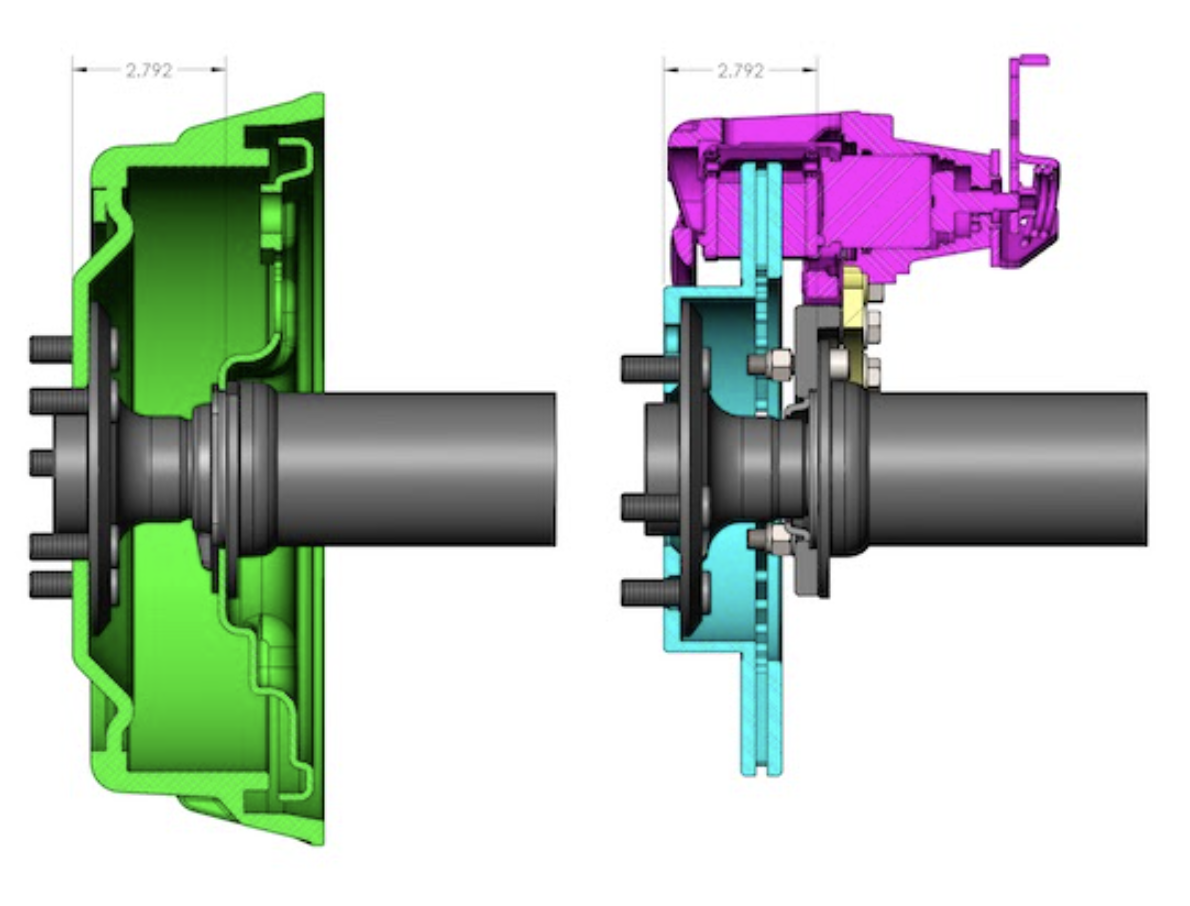
If you’ve ever done a front disc brake conversion on your classic car, you may have had to deal with track width change. As you contemplate investing in a rear disc brake conversion kit, you may be worried about running into the same problem. Will the wheels and tires still fit under the fenders in the original position once the conversion is done?
Here’s the difference between front and rear disc brake conversions when it comes to their effects on track width.
Why Do People Ask About Track Width Change?
Track width change is common with many front disc brake conversions in classic cars. Wheels and tires in the front that previously had drum brakes may be moved from their original position once disc brakes are installed.
The track width may get wider because of some of the components that are used in a front disc brake conversion (such as brake rotors). Because this can happen with front disc brakes, people assume they may have the same issue with rear disc brakes.
However, the setup for the brakes in the front is different from the system in the back.
Why Does Track Width Change Happen With Front Brakes?
In a front drum brake system, many of the original applications in classic cars had a hub and a brake drum. This combination physically positions the wheel on the vehicle.
When front drum brakes are converted to disc brakes, the hub and brake drum are taken away and replaced by a brake rotor. This component may be wider than the original hub and brake drum assembly. The difference could be anywhere from ⅛ inch to ¾ inch, possibly even greater.
Why Is Track Width Change an Issue With Front Brakes?
A change in track width after a front disc brake conversion on a classic car will place the wheel and tire in a different location than the original position. This doesn’t always occur. Situations vary from vehicle to vehicle. But when it does happen, it’s cause for concern.
Track width change becomes an issue when the wheels and tires get too close to the fenders. Making a turn or going over a bump can be problematic. The tire becomes a point of contact, which is something you want to avoid.
Since wheel fitment can be a concern when doing a front disc brake conversion, Master Power Brakes created a tool that can help. It’s a very simple wheel fitment template that’s application-specific and available for our most popular kits.
The template gives a cross-section of the disc brake system that can be placed within the wheel to determine if adequate clearance is available. It’s easy to use. You can click here to learn more.
Does Track Width Change Happen With Rear Disc Brakes?
You may think if track width change can happen with a front disc brake conversion on your classic car, then it will probably occur in a rear disc brake conversion. And if your tires are bigger in the back, you’ll have even less wiggle room if the wheels creep closer to the fenders.
You don’t have to worry. Track width change is not an issue with rear disc brake conversions. Here’s why. In the back, you have to rear-end housing and an axle shaft, which never moves. On the outside of the axle shaft, you would usually have a brake drum, but in a conversion, you place a brake rotor there instead.
Because the axle shaft doesn’t move, and the brake drum and brake rotor are similar in thickness, nothing shifts. And even if it does, it’s such a minuscule amount, you can’t even tell. Brake drums typically measure around 0.250” thick at the center of the drum. Brake rotors are typically the same in thickness and if they are thicker, it will be well less than 0.100” which is not going to be enough to cause a make or break in the installation. See the cutaways below for a comparison between a typical drum brake and one of our disc brake conversions.
No Track Width Change With Rear Disc Brake Conversions
Now you know whether you need to be concerned about track width change in a rear disc brake conversion.
The short answer is no.
Track width change can happen with front disc brake conversions because you’re replacing the hub and brake drum with a potentially bigger brake rotor. But because you’re only replacing the rear brake drum with a brake rotor that’s similar in size, it’s not a concern in the back.
If you have more questions about rear disc brake conversion kits, check out this blog on how easy they are to install. Or feel free to get in touch with one of our Master Power Brakes specialists to talk about any of your classic car concerns.

